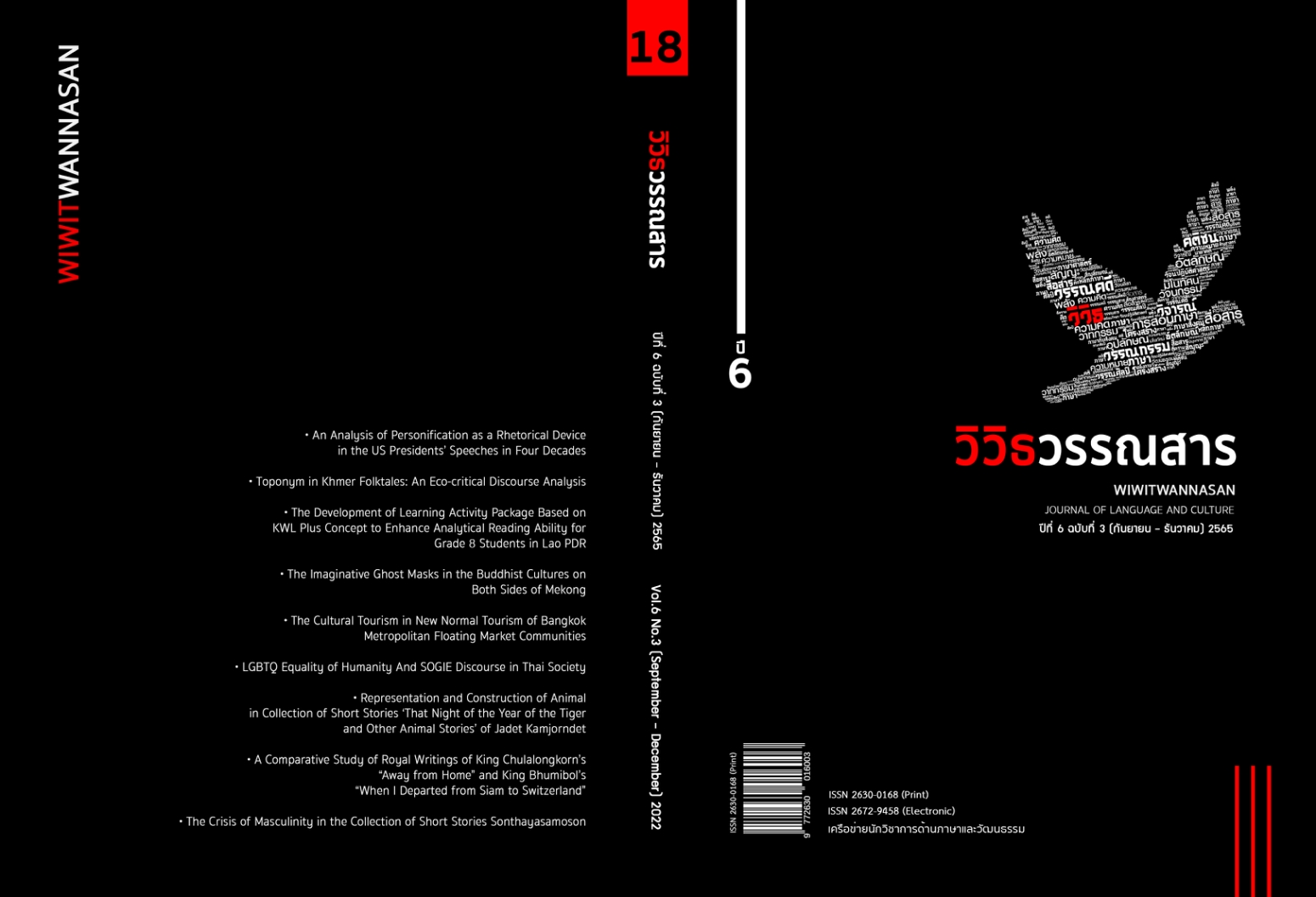การท่องเที่ยวเชิงวัฒนธรรมในมิติวิถีใหม่ของชาวชุมชนตลาดน้ำ พื้นที่กรุงเทพมหานคร
Main Article Content
บทคัดย่อ
บทความวิจัยครั้งนี้มีวัตถุประสงค์เพื่อ 1) ศึกษาบริบทของชาวชุมชนตลาดน้ำพื้นที่กรุงเทพมหานครในด้านลักษณะทางกายภาพของพื้นที่ ประวัติชุมชน ภาษาและวัฒนธรรมท้องถิ่นของชุมชน 2) ศึกษาศักยภาพด้านการท่องเที่ยวเชิงวัฒนธรรมของชาวชุมชนตลาดน้ำพื้นที่กรุงเทพมหานคร และ 3) นำเสนอรูปแบบการท่องเที่ยวเชิงวัฒนธรรมในมิติวิถีใหม่ของชาวชุมชนตลาดน้ำพื้นที่กรุงเทพมหานคร ใช้ระเบียบแบบแผนวิธีวิจัยเชิงคุณภาพ โดยการสัมภาษณ์เชิงลึกและสนทนากลุ่มวิทยากรและบุคคลที่เกี่ยวข้องกับชุมชนชาวตลาดน้ำจำนวน 36 คนจากตลาดน้ำในกรุงเทพมหานคร 6 แห่ง ได้แก่ 1) ตลาดน้ำคลองลัดมะยม 2) ตลาดน้ำขวัญเรียม 3) ตลาดน้ำวัดสะพาน 4) ตลาดน้ำวัดตลิ่งชัน 5) ตลาดน้ำบึงพระยา วัดพระยาสุเรนทร์ และ 6) ตลาดน้ำสำเพ็ง 2 ผลการศึกษาพบว่า 1) บริบทของชาวชุมชนตลาดน้ำ ส่วนใหญ่อยู่บริเวณริมคลอง ชาวชุมชนใช้เรือในการสัญจรไปมาทางน้ำ ประกอบอาชีพเกษตรกรรม มีพืชผลทางการเกษตรเป็นหลัก ใช้ภาษาไทยกลางในการสื่อสาร วัฒนธรรมท้องถิ่นที่สำคัญคือกิจกรรมตักบาตรทางน้ำ ประเพณีที่นิยมจัดคือสงกรานต์ และลอยกระทง จุดเด่นคือการขายสินค้า ขายของที่ระลึกและร้านอาหารรับประทานริมน้ำได้ 2) ศักยภาพ ด้านการท่องเที่ยวเชิงวัฒนธรรม พบว่ามีการดึงดูดใจด้านการท่องเที่ยว การรองรับด้านการท่องเที่ยวและการบริหารจัดการ และ 3) 3)3รูปแบบการท่องเที่ยวเชิงวัฒนธรรมในมิติวิถีใหม่ที่ผู้วิจัยนำเสนอได้แก่ “CSPPC MODEL” มี 5 นวัตกรรม ได้แก่ 1) นวัตกรรมทางความคิด 2) นวัตกรรมการให้บริการ 3) นวัตกรรมการมี ส่วนร่วม 4) นวัตกรรมการป้องกันและ 5) นวัตกรรมการสื่อสาร นอกจากนี้ผลการประเมินรูปแบบ การท่องเที่ยวเชิงวัฒนธรรมในมิติวิถีใหม่ของชาวชุมชนตลาดน้ำพื้นที่กรุงเทพมหานครมีมาตรฐานทุกด้าน ได้แก่ ด้านการใช้ประโยชน์ทั่วไป ด้านความเป็นไปได้ ด้านความถูกต้อง และด้านความละเอียดครอบคลุม
Article Details

อนุญาตภายใต้เงื่อนไข Creative Commons Attribution-NonCommercial-NoDerivatives 4.0 International License.
ลิขสิทธิ์ของบทความเป็นของวารสาร การพิมพ์ซ้ำจะต้องได้ร้บการอนุญาตจากบรรณาธิการวารสาร
เอกสารอ้างอิง
Anusasananun, J. (2012). Changes from the expansion and management of Khlong Lat Mayom Floating Market, (Master’s thesis). Silpakorn University. (In Thai)
Akkharangkun, P. (2010). Tourist Behavior (7th ed.). Khon Kaen: Klungnana vitthaya Press.
Bunmee, B. (2019). People's way of life along the water, Khlong Lat Mayom Floating Market For sustainable tourism, Taling Chan District, Bangkok, (Master’s thesis). Suan Sunandha Rajabhat University. (In Thai)
Bunsiriphan, M. 2021. Get to know "New Normal" edition of the Royal Society.Retrieved from: https://news.thaipbs.or.th/content/292126 (In Thai)
Environmental Research Institute, Chulalongkorn University. (2006). Assessment of quality standards attraction. Bangkok: Chulalongkorn University Press. (In Thai)
Dodds, R., & Butler, R.W. (2019). Overtourism: Issues, Realities and Solutions. Berlin: Walter de Gruyter.
Fennell, D. A. (2015). Ecotourism (4th ed.). New York: Routledge.
Fennell, D.A., & Cooper, C. (2020). Sustainable Tourism: Principles, Contexts and Practices. Bristol: Channels View Publications.
Haocharoen, K. (2018). Local way of life and physical layout of the riverside community Market near Tha Chin River. A case study of Suphan Buri and Nakhon Pathom Provinces. Academic Journal of Faculty of Architecture King Mongkut Institute of Technology LadKrabang, 26 (20), 13-29. (In Thai)
ICOMOS. (2017). ICOMOS ISC Cultural Tourism. Retrieved from http://icomos- ictc.org/wpcontent/uploads/2017/11/Publications- PDF-4
Iso-Ahola, S. E. (1982). Toward a Social Psychology of Recreational Theory of Tourism Motivation: A Rejoinder. Annals of Tourism Research, 9 (2), 256-262.
Joseph, M. C. (2020) Human flourishing, tourism transformation and COVID-19: a conceptual touchstone, Tourism Geographies, 22 (3), 514-524, DOI: 10.1080/14616688.2020.1765016.
Maslow, A. H. (1943). A theory of human motivation. Psychological Review. 50(4), 370–396.
Phichitkun, P. (1988). Geographic scope. Bangkok: Khurusapha. (In Thai)
Phiraphan, W. (2005). Preservation and Revival of Amphawa communities and nearby areas in Samut Prakan. Bangkok: Chulalongkorn University. (In Thai)
Phongsaphit, A. (1999). Culture, Religion and Ethnicity: An anthropological analysis of Thai society (2nd ed.). Bangkok: Chulalongkorn University Press. (In Thai)
Sukhothai Thammathirat Open University. (2018). Culture and Tourism, unit 1-14. Nonthaburi: Sukhothai Thammathirat Open University. (In Thai)
Sammanithi, L. (2011). Formation process and changes in the floating market in the context of Western Chao Phraya River Delta area. Graduate School, Chulalongkorn University. (In Thai)
Sivesan, S. (2019). Challenges of Sustainable Tourism in Ancient Cities: A Case Study Based on Kandy, Sri Lanka. Journal of Business Studies, 6 (1), 57-74.
Thiraphong, K. (2020). Cultural tourism development through experience design. The Fine and Applied Arts Journal, 13 (1), 1-15. (In Thai)
The United Nations. (2018). The Sustainable Development Goals Report 2018. New York: UN.
UNESCO. (2006). Tourism, Culture and Sustainable Development. Retrieved from https://unesdoc.unesco.org/ark:/48223/pf0000147578


